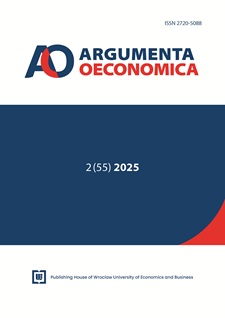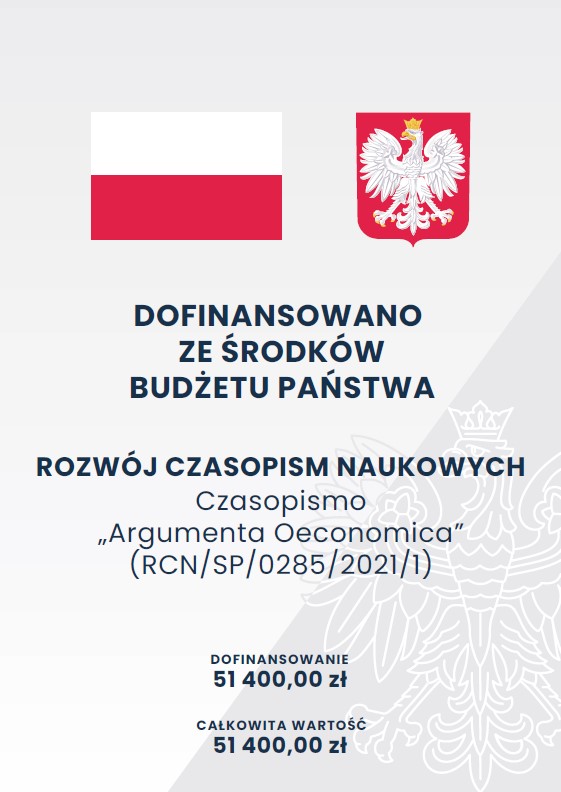Can occupational skills explain the gender wage gap in a developing economy? Evidence from an unconditional quantile regression approach
DOI:
https://doi.org/10.15611/aoe.2025.2.11Keywords:
gender wage gap, skill levels, occupations, glass ceilingAbstract
Aim: This study investigated the gender wage gap across occupational groups in Pakistan differentiated by their skill level. The author intended to explore how wage disparities between men and women vary across low, average, high, and very high-skilled occupations and examines the presence of structural barriers such as the glass ceiling.
Methodology: The study utilised nationally representative microdata from the Pakistan Labour Force Survey (2020-2021) and applied Oaxaca-Blinder decomposition techniques along with unconditional quantile regression models.
Results: The empirical findings indicate that women earn significantly lower wages in low and average-skilled occupations compared to their male counterparts. Conversely, women attain wage parity or enjoy a relative advantage in high and very high-skilled occupations. Nonetheless, evidence of glass ceiling effects persists in low, average, and very high-skilled groups, suggesting that human capital differences alone do not fully explain gender-based wage disparities.
Implications and recommendations: A multi-pronged approach is necessary to reduce the gender wage gap. Policymakers should strengthen labour market regulations, raise minimum wages, enforce equal pay legislation, and promote gender-inclusive work environments. Encouraging women’s participation in high-skilled occupations through targeted training, mentorship, and flexible work arrangements is essential for sustained wage equality.
Originality/Value: This study makes a novel contribution by examining gender wage disparities across occupational skill levels in a developing country using recent data. It also offers disaggregated insights beyond aggregate wage gap estimates, providing actionable evidence for policymakers addressing gender inequality in labour markets across the Global South.
Downloads
References
Acemoglu, D., & Autor, D. (2011). Skills, tasks and technologies: Implications for employment and earnings. In O. Ashenfelter, & D. Card (Eds.). Handbook of labor economics (Vol. 4, pp. 1043-1171). Elsevier.
Agrawal, T. (2021). Gender segregation and wage differentials in India: The role of educational attainment and occupational choices. International Journal of Manpower, 42(1), 1-20.
Ahmed, S., & McGillivray, M. (2015). Human capital, discrimination, and the gender wage gap in Bangladesh. World Development, 67, 506-524.
Akram, N. (2022). Public-Private Wage Differentials: Evidence from Pakistan. The Lahore Journal of Economics, 27(2), 39-64.
Andlib, Z. (2025). Breaking Barriers or Reinforcing Gaps? Gender Wage Disparities Across Skill Levels in a Developing Economy [Unpublished manuscript]. EconStor. Available at: https://www.econstor.eu/handle/10419/309299.2
Andlib, Z., & Khan, A. H. (2018). Low female labour force participation in Pakistan: Causes and factors. Global Social Sciences Review, 3(3), 237-264.
Andlib, Z., & Khan, A. H. (2019). The paradox of out-of-labor-force educated women in Pakistan: Evidence from PSLM 2013-14 Household Survey. The Journal of Humanities and Social Sciences, 27(2), 201.
Andlib, Z., & Zafar, S. (2023). Women and vulnerable employment in the developing world: Evidence from Pakistan. Journal of International Women's Studies, 25(7), 17.
Aslam, M. (2009). Education gender gaps in Pakistan: Is the labour market to blame? Economic Development and Cultural Change, 57(4), 747-784.
Bennedsen, M., Larsen, B., & Wei, J. (2023). Gender wage transparency and the gender pay gap: A survey. Journal of Economic Surveys, 37(5), 1743-1777.
Biagetti, M., & Scicchitano, S. (2011). A note on the gender wage gap among managerial positions using a counterfactual decomposition approach: sticky floor or glass ceiling? Applied Economics Letters, 18(10), 939-943.
Bjerge, B., Torm, N., & Trifkovic, N. (2021). Can training close the gender wage gap? Evidence from Vietnamese SMEs. Oxford Development Studies, 49(2), 119-132.
Blinder, A. S. (1973). Wage discrimination: Reduced form and structural estimates. Journal of Human Resources, 436-455.
Bonacini, L., Gallo, G., & Scicchitano, S. (2024). Does working from home increase the gender wage gap? Insights from an Italian survey of occupations. Feminist Economics, 1-36.
Cheema, A. R., Saleem, A., Haq, J. U., & Shehzadi, B. (2022). Estimating gender wage gap and its decomposition in Pakistan. Journal of Quantitative Methods, 6(2), 26-50.
Cheng, H., Hu, D., & Li, H. (2020). Wage differential between rural migrant and urban workers in the People’s Republic of China. Asian Development Review, 37(1), 43-60.
Christofides, L. N., Polycarpou, A., & Vrachimis, K. (2013). Gender wage gaps, ‘sticky floors’ and ‘glass ceilings’ in Europe. Labour Economics, 21, 86-102.
Deshpande, A., Goel, D., & Khanna, S. (2018). Bad karma or discrimination? Male-female wage gaps among salaried workers in India. World Development, 102, 331-344.
Duraisamy, M., & Duraisamy, P. (2016). Gender wage gap across the wage distribution in different segments of the Indian labour market, 1983-2012: Exploring the glass ceiling or sticky floor phenomenon. Applied Economics, 48(43), 4098-4111.
Faizan, M., & Khan, M. N. (2022). Gender discrimination & wage gap in the perspective of the banking sector of Pakistan. International Journal of Social Science & Entrepreneurship, 2(1), 40-51.
Ferber, M. A., & Nelson, J. A. (Eds.). (2009). Beyond economic man: Feminist theory and economics. University of Chicago Press.
Firpo, S. P., Fortin, N. M., & Lemieux, T. (2009). Unconditional quantileregressions. Econometrica, 77(3), 953-973.
Firpo, S. P., Fortin, N. M., & Lemieux, T. (2018). Decomposing wage distributions using recentered influence function regressions. Econometrics, 6(2), 28.
Fortin, N., Lemieux, T., & Firpo, S. P. (2011). Decomposition methods in economics. In Ashenfelter, O., & Card, D. (Eds.). Handbook of labor economics (Vol. 4, pp. 1-102). Elsevier.
Gaeta, G. L., Lavadera, G. L., & Pastore, F. (2022). Overeducation wage penalty among Ph. D. holders: an unconditional quantile regression analysis on Italian data. International Journal of Manpower, 44(6), 1096-1117.
Gallo, G., & Pagliacci, F. (2020). Widening the gap: the influence of ‘inner areas’ on income inequality in Italy. Economia Politica, 37(1), 197-221.
Gharehgozli, O., & Atal, V. (2020). Revisiting the gender wage gap in the United States. Economic Analysis and Policy, 66, 207-216.
Goldin, C. (2014). A grand gender convergence: Its last chapter. American Economic Review, 104(4), 1091-1119.
Goldin, C. (2021). Career and family: Women’s century-long journey toward equity. Princeton University Press.
Goldin, C., Kerr, S. P., Olivetti, C., & Barth, E. (2017). The expanding gender earnings gap: Evidence from the LEHD-2000 Census. American Economic Review, 107(5), 110-114.
Government of Pakistan, Pakistan Bureau of Statistics. (2023). Labour force survey of Pakistan 2020–21. Pakistan Bureau of Statistics.
Hakro, A. N., Ghulam, Y., Jaffry, S., & Shah, V. (2021). Returns to Education and Wage Inequality in Pakistan. The Journal of Developing Areas, 55(3), 1-22.
Iwasaki, I., & Satogami, M. (2023). The gender wage gap in European emerging markets: A meta-analytic perspective. Journal for Labour Market Research, 57(1), 9.
Koenker, R., & Bassett Jr, G. (1978). Regression quantiles. Econometrica: Journal of the Econometric Society, 33-50.
Lim, K., & Zabek, M. (2024). Women’s labour force exits during Covid-19: Differences by motherhood, race, and ethnicity. Journal of Family and Economic Issues, 45(3), 504-527.
Malik, A. I., & Akram, N. (2024). Determinants of the gender wage gap in Pakistan. SN Business & Economics, 4(2), 26.
Manji, F. (2000). Review of the book Development as freedom, by A. Sen. Development in Practice, 10(2), 258–259.
Moran, C. (2017). Why feminist economics is necessary. Exploring Economics. https://www.exploring-economics.org/en/discover/Why-feministeconomics-is-necessary/
Oaxaca, R. (1973). Male-female wage differentials in urban labour markets. International Economic Review, 14(3), 693-709.
Poddar, S., & Mukhopadhyay, I. (2019). Gender wage gap: Some recent evidence from India. Journal of Quantitative Economics, 17, 121-151.
Rahman, M., & Al-Hasan, M. (2019). Male-female wage gap and informal employment in Bangladesh: A quantile regression approach. South Asia Economic Journal, 20(1), 106-123.
Rahman, M., & Al-Hasan, M. (2022). The reverse gender wage gap in Bangladesh: Demystifying the counterintuitive. The Indian Journal of Labour Economics, 65(4), 929-950.
Rothe, C. (2010). Nonparametric estimation of distributional policy effects. Journal of Econometrics, 155(1), 56-70.
Said, M., Majbouri, M., & Barsoum, G. (2022). Sticky floors and glass ceilings: gender wage gap in Egypt. Feminist Economics, 28(4), 137-165.
Scicchitano, S. (2012). The male-female pay gap across the managerial workforce in the United Kingdom: A semi-parametric decomposition approach. Applied Economics Letters, 19(13), 1293-1297.
Seneviratne, P. (2020). Gender wage inequality during Sri Lanka’s post-reform growth: A distributional analysis. World Development, 129, 104878.
Siddiquee, M. S. H., & Hossain, M. A. (2018). Exploring the gender wage gap in the urban labor market of Bangladesh. Research in Applied Economics, 10(1), 36-58.
UNESCO. (1997). International Standard Classification of Education: ISCED 1997. United Nations Educational, Scientific and Cultural Organization. https://uis.unesco.org/en/topic/international-standard-classification-education-isced
Wihardja, M. M., & Pradana, A. T. (2024). Examining the drivers of changes in mean earnings and earnings inequality in Indonesia. Asian Economic Journal, 38(2), 232-255.
Yamamoto, Y., Matsumoto, K. I., Kawata, K., & Kaneko, S. (2019). Gender-based differences in employment opportunities and wage distribution in Nepal. Journal of Asian Economics, 64, 101131.
Yasmin, S., Jamil, M., & Iqbal, M. (2021). The gender wage gap in Pakistan: Extent, trends, and explanations. Forman Journal of Economic Studies, 17(2).
Downloads
Published
License
Copyright (c) 2025 Zubaria Andlib

This work is licensed under a Creative Commons Attribution-ShareAlike 4.0 International License.
Accepted 2025-05-22
Published 2025-10-22








